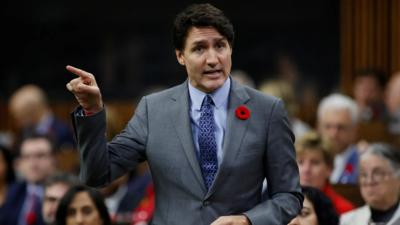- News
- World News
- Rest of World News
- Trudeau explains cap on immigration: 'We made mistakes, system exploited by bad actors'
Trending
Trudeau explains cap on immigration: 'We made mistakes, system exploited by bad actors'
Canadian Prime Minister Justin Trudeau addressed concerns about the country's immigration system, acknowledging past exploitation and announcing reduced immigration targets for the next three years. The decision aims to allow Canada's infrastructure, including housing and social services, to catch up with the influx of newcomers while ensuring a sustainable system for both immigrants and Canadians.

The new policy, which aims to address these issues, introduces significant reductions in the number of both permanent and temporary residents entering Canada over the next three years.
The Trudeau government is currently facing major scrutiny in Canada, and are currently trailing the Conservative party in polls ahead of elections scheduled next year.
Trudeau further discussed how Canada's immigration system had been influenced by these "bad actors," such as fake colleges and large corporations that capitalised on the post-pandemic demand for workers. He explained that while the immigration system was designed to bring in workers and students, it became clear that some were abusing the system to make a profit. "Far too many colleges and universities used international students to raise their bottom line," Trudeau pointed out.
'Immigration is based on demand'
"Temporary foreign workers became such a significant part of our workforce that it’d be a mistake not to include them when we plan our immigration levels," he explained, adding that "immigration is based on demand".
Trudeau’s remarks also centred on the need to balance immigration levels with Canada’s existing infrastructure. He noted that while businesses and various sectors were eager to welcome workers, the country’s housing, healthcare, and social services had not kept pace. The new cap, therefore, aims to allow the economy and communities some time to adjust. "This pause is going to give our economy and our communities the chance to catch up with things like our plan to build millions more homes," Trudeau stated.
Trudeau highlighted how the cap on international students had already led to rental prices in major cities like Toronto and Vancouver starting to decline. "Rents will keep coming down," Trudeau added, reinforcing that the immigration changes are intended to make the system work for both newcomers and Canadians.
Why Canada’s changing its immigration system
What the new plan looks like
The new immigration levels plan for 2025-2027 reflects these adjustments, with a 21% reduction in the number of permanent residents expected to be admitted. The target for permanent residents has been cut from 500,000 to 395,000 in 2025.
The new immigration plan will see a sharp decrease in the number of new temporary residents entering Canada. By 2026, the number of temporary workers is expected to drop by over 40%, and the target for international students will also decrease by 10%. The overall number of temporary residents in 2025 is projected at 673,650, with temporary workers and students making up the majority.
End of Article
FOLLOW US ON SOCIAL MEDIA











